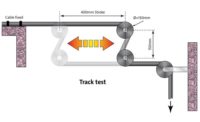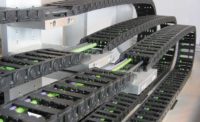Environmental Considerations:
Vacuum or low temperature chambers
Machine vision can be found in the most interesting of locations, from food sorting equipment to deep in space. Temperature, moisture, pressure or the absence of pressure can create some challenges when the camera must be isolated from the computer. In the case of sorting or inspection of foods that must remain frozen or at very low temperature, moisture can wick through the cable due to the difference of temperature and humidity from one end of the cable located in the isolated chamber to the other end located outside the chamber. This moisture can cause issues for the longevity of the vision equipment and in maintaining an isolated environment. Moisture or differential pressure can work its way through the tiniest of openings in the connector and through the length of the cable. This can be prevented.
Although the connectors at the camera end or computer end are not easily converted to a more environmentally sealed connector, an intermediary connection can be made that will provide an environmental barrier. Through the use of a sealed connector such as a 38999 series connector, each wire is terminated to a pin and socket which passes though an air/liquid tight grommet, thereby preventing unwanted contamination between the camera and computer environments. This connection can also serve as an ideal bulkhead connection allowing for a quick disconnect of the camera from the computer. This type of connector is commonly used in military applications.
LSZH (Low Smoke Zero Halogen)
When fires occur in relatively enclosed areas, the majority of fatalities result from smoke and gas inhalation rather than contact with the fire itself. As a result, extensive research and development has been done to reduce the emission of smoke and gases during a fire. Traditional cables will emit smoke and hazardous gases when exposed to flames; this can be extremely dangerous in small areas such as isolation chambers, aircraft and underground tunnels. This risk can be greatly reduced with the use of low smoke/zero halogen compounds in place of the typical PVC or polyurethane materials used on most cables. These cables can be also referred to as LSHF (Low Smoke Halogen Free), LS0H (Low Smoke Zero Halogen), 0HLS (Zero Halogen Low Smoke) and HFFR (Halogen Free Flame Retardant).
Low particulation
For those clean room applications, great care is taken to ensure that contamination is not introduced into the environment from an external source. This is often achieved through isolation of the work area and rigorous air filtration systems that can remove the finest of particles from the air. However, particles can also be created within the isolated work area. Applications under constant motion have the risk of generating contamination due to the abrasion that may occur when two cables rub against each other at different rates of speed, resulting in small particles from the cables abrading and contaminating the product. Cables are manufactured with many various materials such as PVC, polyurethane and silicon, all of which will abrade to some extent, some much more than others. The use of low-particulating materials such as PTFE in a cable will greatly reduce the risk of these particles contaminating the product.
Motion Considerations:
High/Continuous Flex applications
Approximately 90% of machine vision applications are in a static state, or where the camera or cable does not move. For the remaining 10% of applications that are dynamic and see repetitive motion, ensuring the cable lasts the desired amount of cycles requires more than what a standard grade cable can provide. The biggest contributors to the failure of a cable in a high flex application are the size of the bend radius (larger bend radius will provide longer cable life) and abrasion of the components within the cable. Several high flex/ continuous flex cables exist which allow for millions of repeated cycles while maintaining excellent signal integrity. Although the majority of these cables are round, some unique cables exist which are planar or flat in shape. These planar cables allow for a much smaller bend radius, allowing it to be used in areas where a larger round cable may not fare as well in the life of the application. An example of one of these planar cables is a cable constructed in such a way that instead of having the 11 individually shielded twisted pairs and four discrete wires laid up in a cylindrical orientation, the cable is broken up into six pods laid out in a flat array, with each individually shielded pod containing two twisted pairs. This planar array along with the use of PTFE insulation and jacket provides a cable that can hold up to the most challenging of high flex applications. Other cables exist as well and it is important to ask the cable manufacturer for any test data demonstrating the cable’s suitability for a particular application. Some cable manufacturers may also offer cable flex testing on test equipment set up to closely replicate your specific application.
Continuous Camera and Cable Rotation
The use of a camera and cable in a continually rotating application would typically not be possible due to the cable twisting about itself to the point of failure. Most vision systems incorporate the use of a cable that has multiple conductors or pairs. If a cable can be reduced to just one conductor and provision made for the rotation of that single conductor, continuous rotation of the camera and cable is possible.
Connector Considerations:
Breakout/Bulkhead connections
Applications using multiple cameras and cables can become quite a challenge when routing cables from the camera to the computer. Utilizing a multi-position connector can allow multiple cameras and cables to be routed through one single connector and cable, enabling a much more compact and organized cable layout compared to multiple cables going through the same space. As mentioned earlier a bulkhead connection can be utilized when the camera is located in an area isolated from the computer. One thing to keep in mind for those applications that incorporate a longer length cable: a small amount of effective cable length is sacrificed when incorporating an additional connection.
Hopefully these ideas will help in finding potential cable and connector solutions for non-standard applications. While these types of applications may not be commonplace, it is useful to know what possible solutions may already exist when they do arise.








